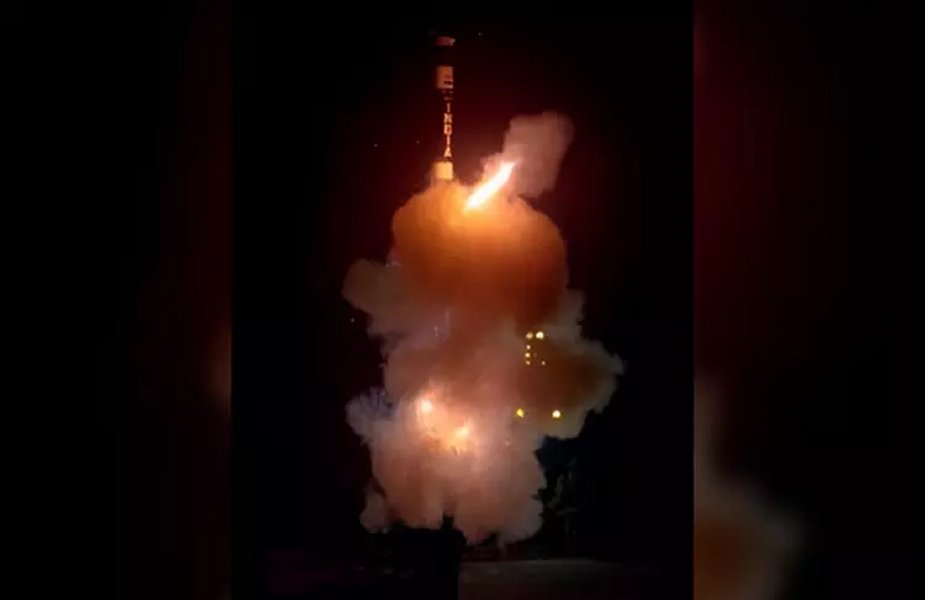Breaking news
India succefully test last generation ballistic missile AGNI-PRIME.
India’s Strategic Forces Command (SFC) and Defence Research and Development Organisation (DRDO) celebrated the successful flight test of the Agni-Prime ballistic missile from Dr APJ Abdul Kalam Island off the Odisha coast. The planned test, conducted at approximately 19.00 hrs on April 3, 2024, showcased the missile’s performance, meeting all trial objectives.
Follow Army Recognition on Google News at this link

flight test of the Agni-Prime ballistic missile off the coast of Odisha.(Picture source: X/@DRDO_India )
The Agni missile family represents a series of ballistic missiles developed by India as a part of its strategic deterrence policy. Spearheaded by the Defence Research and Development Organisation (DRDO), the Agni series plays a crucial role in India's defense architecture, providing the country with a range of offensive capabilities. Here's an overview of the Agni missile family, highlighting its evolution and diversity:
- Agni-I as a short-range ballistic missile (SRBM), has a range of approximately 700-1250 kilometers. It was developed as a technology demonstrator and has since been operationalized, serving as a strategic asset capable of carrying conventional and nuclear warheads.
- Agni-II: a medium-range ballistic missile (MRBM) extends the reach of India's strategic arsenal, with a range of about 2,000-3,000 kilometers. Agni-II is designed for mobility and can be launched from both rail and road mobile launchers.
- Agni-III: as an intermediate-range ballistic missile (MRBM), has a range of 3,000-5,000 kilometers, and marks a significant advancement in terms of range and payload capacity, enabling India to target more distant threats effectively with nuclear power.
- Agni-IV: This missile is considered an IRBM with improved accuracy and a range of approximately 3,500-4,000 kilometers. Agni-IV incorporates advanced technologies for navigation and guidance, ensuring higher precision.
- Agni-V: As an intercontinental ballistic missile (ICBM), has a range of over 5,000 kilometers. It is capable of carrying a nuclear warhead and is designed to strengthen India's nuclear deterrence capabilities, with the potential to reach targets across Asia and into Europe.The last test flight was conducted on march 2024.
- Agni-Prime: The latest in the series, Agni-Prime is a next-generation MRBM with features such as canister-launching for enhanced mobility and rapid deployment. Its range is estimated to be between 1,000 and 2,000 kilometers, and it incorporates advanced technologies for improved accuracy and reliability.
The Agni-Prime and Agni-V missiles differ significantly in their design and operational capabilities. The Agni-Prime is a more recent, medium-range ballistic missile (MRBM) with an estimated range of 1,000 to 2,000 kilometers, designed for rapid deployment and high mobility. Its canister launch system, allowing for road mobility, significantly enhances its operational flexibility and readiness, making it a quick-response weapon. In contrast, the Agni-V is an intercontinental ballistic missile (ICBM) with a much longer range, exceeding 5,000 kilometers, intended for deep strike capabilities and designed to reach across continents, reinforcing India's position as a major nuclear power. The technological advancements in the Agni-Prime, such as improved guidance, navigation, and re-entry technologies, reflect the evolution of India's missile development program, focusing on versatility and survivability. Meanwhile, the Agni-V's extended range and payload capacity underline its role in strategic deterrence, offering a broader reach against potential adversaries.
The Agni-Prime’s flight trajectory, tracked by a network of range sensors, including two downrange ships stationed at the terminal point, showed its reliability. The launch event witnessed the presence of dignitaries, including the Chief of Defence Staff, the Chief of Strategic Forces Command, and senior officials from DRDO and the Indian Army.
The border dispute between India and China is a major factor accelerating multiple missile procurement programs. India is the second-largest spender in the regional MMDS market. According to GlobalData’s “The Global Missiles & Missile Defense Systems Market 2023-2033” report, India is reinforcing its defense capabilities through recent developments in missile technologies.
Minister of Defence Raksha Mantri Shri Rajnath Singh lauded the collaborative efforts of DRDO, SFC, and the Armed Forces, emphasizing the significance of the successful test in augmenting India’s defense capabilities. He hailed the Agni-Prime as a potential force multiplier poised to enhance the nation’s deterrence posture.
Defense News April 2024






















